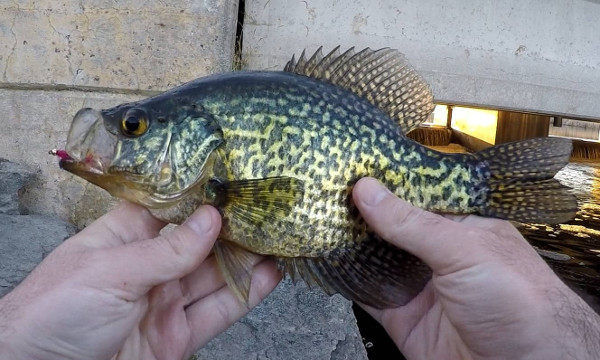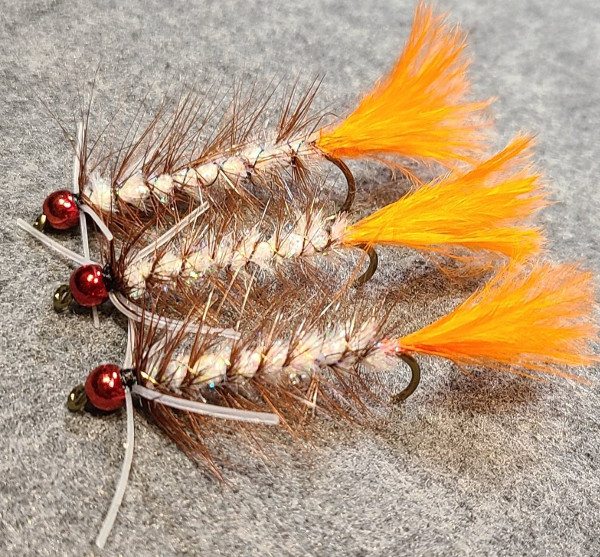
Crappie are an ideal fish species to target by fly fishing, and it’s honestly surprising you don’t see it more often. They are an extremely popular panfish, and are typically targeting on ultra-light spinning gear. The lures used for crappie fishing often look suspiciously like flies that we fly anglers use all the time. An ultra-light jig, some chenille, and a touch of marabou and you have standard spin casting marabou crappie jig.
Crappie Variety
There are actually two different species of Crappie. Black Crappie and White Crappie.
The variety of fish found in my area are Black Crappie, so the advice below is for this fish specifically. My understanding is that White Crappie are similar enough that the techniques and flies mentioned below should work just as well when fly fishing for them.
When and Where to Fish for Crappie
Spring
In terms of seasonality, spring is by far the easiest time to target crappie. This is especially true if you’re wading (aka most fly anglers) or fishing from shore. Crappie enter shallow water in the spring to breed, making them easy fly fishing targets at this time.
If you’re a warm water angler, crappie season fits in perfectly between ice out and the opening of more popular sport fish species. The season for gamefish such as bass, pike, and walleye is typically closed during this time. Making crappie the perfect fish to fill in an otherwise dull time of the fishing season!
If you live close to trout water it’s a bit of a different situation. The timing of crappie coming in shallow overlaps with some prime spring trout fishing. Dedicated trout anglers may have to sacrifice some trout time to chase crappie.
So where do you find crappie in the spring? Crappie are triggered to spawn once the water warms appropriately. They’ll start to come inshore when temperatures reach around 10C (50F) – 15C (60F), with breeding activity peaking around 20C (68F). Wait for two or three days of warm sunny weather peak fish activity. A day or two of cold, cloudy weather will drive crappie back into deeper water during early spring.
They’ll seek out this warmer water to spawn, so look for areas that warm up first. Calm back bays or dam overflows (looking for warm surface runoff, not dams that release water from the base of the dam) are good places to look for crappies in the spring. If the water is sheltered from the wind, that’s a plus as well.
The rest of the year
For the remainder of the season, you have to look to deeper water. Black Crappies spend most of the year in open water or around deeper structure. This makes owning a boat a huge asset when chasing crappie in the summer and fall. Looks for structure, specifically downed trees and large branches. They can also be found either suspending in the water column or around heavy vegetation. If fishing around heavy vegetation, weedless flies are recommended.
Crappie Fly Selection

Crappie are far from selective feeders, and you can catch them on a variety of flies. Still, I’ve found that chucking streamers is the most effective way to target crappie. This is due to the fact that they prey heavily on small baitfish.
No need to get complicated with fly selection. Woolly buggers, seal fur leeches, and marabou leeches have been the most productive fly patterns for me, and make up the majority of my crappie fly box. You can see a little pink BH seal fur leech in the picture at the start of this article, that is a killer crappie fly pattern!
Crappie much prefer to approach prey from the bottom. When presenting the fly, you want to have the fly above the fish. When fishing streamers, floating lines and lightly weighted flies are ideal.
The most productive colours for me have been white, pink, and (of course) chartreuse. The flies I use for crappie range from a size 2 to size 12. I tend towards the larger side of this range.
If you’re in any doubt as to what flies to use, check out what the spin anglers are using and match the size, profile, and colour to whatever lure or jig they’re having success on. Or you could skip that step and just match the hatch of whatever baitfish are present in the water you’re fishing.
Even though I’ve had the best luck swinging streamers, crappie eat bugs too! Float (bobber) fishing is a common and effective method with spin anglers, so nymphing with an indicator will also productive.
Dragonfly, damselfly, and other nymphs all start to get more active as the water warms up, and these bugs are preyed upon by crappie. Nymphs that imitate these and other insects present in the waterbody you’re fishing will be effective.
Given that you’ll likely be targeting crappie in the spring, you may find yourself fishing water with significant ground runoff. Spring rains will wash worms into the water, and are common forage items for almost every fish species.
If you want to nymph for crappie while imitating a minnow rather than an insect, use a balanced leech fly under an indicator. This method can be deadly effective, especially earlier in the season when the fish are more lethargic.
As mentioned above, crappie prefer to strik prey from below. This makes them good candidates to try and target with topwater flies topwater flies. Generally, later in the season (IE warmer weather), you’re more likely to get a fish to take topwater than earlier in the season.
Crappie Fly Fishing Equipment
There’s no reason to go expensive on the gear you’ll use for targeting crappie. The flies used and the fish themselves are quite forgiving on even entry-level fly gear.
Fly Rod and Fly Line
One of those Fly Fishing Combo Starter Package (Amazon Link) (The ones that include the fly line, fly reel, and fly rod, sometimes a few flies too!) is more than enough to get you started chasing crappie on the fly. A beginner trout fly rod setup will do fine. If you have the means or desire to get fancier equipment though, by all means do so!
You will want to go on the lighter side for your crappie fly fishing gear. After all, these are panfish, not salmon! You don’t have to worry about a crappie dragging you into your backing or breaking you off. That being said, they are feisty fish. A 10″ plus crappie (which is by no means a huge one) will put up a fun fight on lightweight equipment
Anything from a 3 weight to a 6 weight is appropriate for targeting crappie. The lighter you go, the more fun the fights will be!
Even though they’re smaller fish, streamers are more effective than dries in targeting crappie. Streamers typically take a rod with bit more punch to be able to cast effectively than dry flies do. Lighter rods have a harder time throwing bigger flies. So if you plan on throwing larger bead-head woolly buggers (around size 2), err on the side of 5 to 6 weight. A rod this size can double as a smallmouth bass rod.
If you’re going to stick to throwing size 8-10 leeches and buggers, and want a dedicated panfish rod, then a smaller rod in the 3-4 weight range will do just fine.
Leader and Tippet
I don’t go very fancy here. I just tie on a straight foot or two of 8lb mono or flouro. Flouro if I want to get a bit deeper, mono if I want to keep the fly closer to the surface (or even try for topwater action!). I tend towards the flouro as it’s has a bit of bite resistance, and there’s alot of hammer handle pike in some of the crappie fishing spots I frequent that are eager to steal a streamer.
As for landing them. YOu can land them by hand, but a typical sized trout net works very well for landing crappie.

1 thought on “Fly Fishing For Crappie – Techniques, Gear, and Flies”